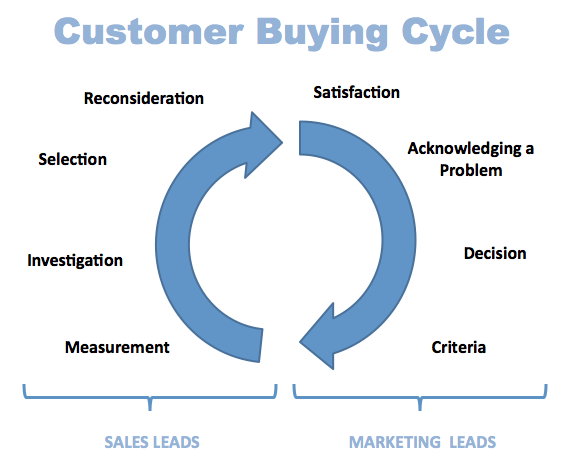
by gabriel_sales | Nov 29, 2012
Understanding the difference between a Sales Cycle vs. Buying Cycle may be the most critical shift an organization needs to make to see significant and sustained revenue growth, especially for complex or highly competitive sales.
In a nutshell, the Sales Cycle is how your company looks at moving deals through their own sales pipe and sales process to close deals. Typically the flow looks something like a lead, marketing qualified lead, sales qualified leads, needs analysis, proposal, negotiation, verbal, and closed. This is a company centered view.
A buying cycle is looking at your sales cycle from what the customer needs. Probably the best example we have seen of a buying cycle is from Robert Jolles book Customer Centered Selling. Below is our brief explanation of how we look at this cycle, addressing some of the implications it has for us as an outsourced sales and marketing company with how we divide the sales and marketing functions.

Phase 1 – Intention to Buy
- The buyer starts satisfied with their current solution
- The buyer acknowledges to themselves that they are not satisfied
- The buyer makes the decision to do something about it
- The buyer starts to think about “what are the criteria” to consider moving forward
As a lead generation and a demand generation company, we understand that intention is meaningless without action. The world is full of people with great intentions that never actually take any action. Your job as a sales person and marketer is to understand that your first task in generating demand for your solution is to help educate a buyer on the “criteria” they need to consider. You need to appreciate that given a choice, most buyers will sit on the fence for as long as possible. They want to move forward, they know it’s good for them to move forward, so you need to help educate the buyer enough so they do in fact move forward. Your first job as a sales and marketing professional is to inspire and catalyze the desire that gets your buyer to move from the passive buying process to the active buying process. More and more, this is becoming the function of your content marketing and inside team.
Phase 2 – Active Buying
- The buyer needs to figure out how to measure the solution to: justify the purchase, understand the impact of doing nothing vs. changing, see the impact on topline, recognize the implications for bottom line, feel subjective relief of pain or risk
- The buyer investigates deeply, typically with short list of solutions and a deep dive into one or more solutions
- Selection is made; a front-runner is chosen
- The buyer reconsiders their decision
During the “Active” buying process, your sales team is typically on point. It’s at this point that marketing should take a back seat – with one exception: marketing needs to continue to support the sales team with the content they need to help deal with the reconsideration phase of the sales cycle. Your marketers need to be prepared to help the buyer remember why they were no longer satisfied and embarked on their buying cycle in the first place.
by Glen Springer | Nov 8, 2012

As a recap of the first blog in this series – we know that the buying process has changed dramatically over the past several years. The buyer, not the seller, now controls the sales process and that process is being “consumerized”. In Part 1 of this series we discussed what you need to consider and be prepared for if you are ready to drive some meaningful cultural change and increased revenue for your organization. Part 2 we will now discuss how your culture, attitude and team dynamics may need to shift to facilitate you customer’s buying process not your sales process.
You need to be prepared for a longer sales cycle. You need to accept that buyers have extended their purchase cycle by 1.5X since 2008 (Sirius-2012) and revenue growth is now going to be both a marathon and a sprint. Your sales team job still needs to be focused on hitting monthly, quarterly and annual sales targets. You need to accept that they may get some deals into the pipe that are going to go through the first several stages of their buying cycle and your sales cycle and then the buyer is going to hit the pause button. You need to have a plan for what happens when this occurs. Does the lead stay with the sale rep or does it go back to your inside sales team? Is there a way to stay in front of them without the sales team wasting time and spinning their wheels?
That your buyers want and expect to be educated first. You may need to embrace the need to develop some new disciplines and commit to content marketing. This is probably the most radical change and your most significant opportunity. Marketing is going to need to take you buyer further through your sales process because that’s what your buyers want. The days when you generate a lead and toss it over to sales are over. And marketers can’t do this alone. They will need the support and contribution of your executives and product specialists as thought leaders. If your marketers can leverage your thought leaders, they can exponentially support your sales team and keep them focused on selling. Marketing can take care of early stage engagement. If you marketer has never been a sales person they may need some help on this front.
Sales and marketing need to work together. The days of working in a silo are over. For a lot of companies this is the biggest hurdle because it’s cultural. Sales doesn’t always care what marketing does (they just want more leads) and marketers don’t think sales appreciates or even understands what they do (and they are often correct). Like any successful team to compete and win, you are going to need to align sales and marketing with the tools, content, and processes you need to support your inside sales reps with the content you need to demonstrate your thought leadership and differentiators. There needs to be mutual respect.
Embrace technology. Because technology can bring the sales and marketing teams together – with the advent of marketing automation platforms, Google Analytics, and CRMs, you can now define and implement a Sales Architecture, Infrastructure, and Technology Platform that provides complete transparency and accountability throughout your entire sales process. Keeping score helps teams to flourish. This isn’t rocket science. Just head out to any Little League or Soccer Field on a Saturday during a game and compare it to what happens during practice. During practice the energy level and focus waxes and wanes. Put them on the field when they are accountable for a score and measured on the results and everything changes and it’s a great deal more fun as well.
You need to budget appropriately. As we mentioned previously, sales is now both a marathon and a sprint. While we appreciate the need and pressure to hit quarterly numbers, don’t expect a process to fall in place that quickly. You need plan on investing in this engine for at least 4 to 6 months until you will start seeing consistent results. As the process becomes imbedded into your culture and your teams align and start firing on all cylinders, revenue will go up and costs of sales will start to decrease. This double gain allows you to take your new revenue and your cost savings to grow the engine producing exponential results.
Summary – The line between sales and marketing is getting blurred
- Your buyer now wants to be educated
- They want access to your thought leadership and your product specialists for deeper education
- Your thought leaders can’t spend time on deals that just want to be educated
- Your buyer does not want to engage with sales until they are educated and ready to buy
- You need to demonstrate you understand their situation and pain before your prospect will engage with sales.
Everyone understands the social contract between salesperson and buyer. The sales person’s job is to sell and the buyer’s job is to buy. Pain, gain, and solution selling are still important but, more and more, rather than having a sales rep get on the phone saying “lets understand your situation”, it’s becoming the job of your inside sales team and your marketers to do this by sharing thought leadership from your product specialists. Pressing the buyer to buy and introducing a sales rep prematurely before they are ready engage may win you a couple of deals in the short term but, it will drive even more deals into your competitors’ arms.
So the question is what does my sales and marketing organization need to look like to create demand for my sales team now that marketing’s job is to take my buyers well beyond creating awareness and driving leads into my sales funnel? Here is our next blog in the series that outlines The Core Competencies I Need From My Demand Generation Team.
If you want to learn more about how Gabriel Sales can apply some of what we have learned for your business specifically, request a complimentary review. If you want to review more information, Download the White Paper for Tactics you can implement now that will jump start your transformation immediately.
Additional Blogs in this Series:
Part 1 – Increasing Your B2B Sales Volume and Revenue – What’s Changed?
Part 2 – What Does Your B2B Sales and Marketing Culture Need to Look Like?
Part 3 – What Core Competencies do I Need From My Marketing and Lead Generation Team?
Part 4 – How Can Marketing Automation Improve My B2B Sales Performance?
Part 5 – Why is Content Marketing is Now Required for Quality B2B Lead Generation?
by Glen Springer | Nov 2, 2012

Selling No Longer Works This Way!
This is the first blog in a four part series that talks about how to increase b2b sales volume, including the radical shift in B2B sales and the changes you can start to make to your to B2B lead generation and B2B demand generation tactics, and B2B sales tactics to set a course that can more than double your volume and revenue growth over the coming 18 months.
The series will discuss what has caused the shift in B2B sales (as a hint buyers don’t buy the way the used to), how this change in volume and revenue impacts your business and why you may need to change your approach , why marketers are more important than ever in your sales process and how you can turn this knowledge into a significant B2B sales and B2B lead generation advantage in 2013 to shift your approach to get it right.
And there is no doubt that you need to get it right because according to a recent study by Adam Needles companies that have embraced selling to the buyer the way they want to buy have seen an increase in revenue of 157% over the past 2 years. Companies that continue to sell “old school” (banging the phone, blindly running campaigns, and relying on solely on tradeshows and the occasional webcast) have seen stagnant sales while simultaneously experiencing an increase in what it costs to sell. Double downside vs double upside.
The good news is that, according to Forrester Research, we are still only at 10% market adoption of companies that have totally nailed the new paradigm, so you can turn your competitors ignorance into your gain. The even better news for Small Businesses is that according to the same study it takes a Fortune 2000 competitor 18 months and twice the costs to turn around their culture because of the fiefdoms and resistance inherent in larger organizations.
What’s Changed
So what’s changed? Unless you have had your head in the sand you know that its tougher to get your buyer on the phone (our connect ratios – someone picking up the phone on the other end when you dial has dropped from 18%-21% to 6%-11% over the past 2 years). And we all know that the sales cycle has increased volume and revenue by about 1.5X to 2X (that’s months, quarters or even a calendar year depending on your sales cycle. It’s not rocket science to figure out that the buyer and not the seller now controls the sales process. That simple fact is the one thing you need to keep top of mind throughout this series.
Buyers are More Risk Adverse
It’s not 2006 anymore. The stock market bounces up and down daily. Experimental budgets have been cut. There are both real and imagined geo-political and domestic issues that get exacerbated and hyped by a 24 hour news cycle. There is a great deal more that is perceived to be out of our control so if you have a budget you do control folks are now much tighter with it. Buyers want to be smarter and more cautious before they buy.
There are more people involved in the buying process
Since 2009 there are more people involved in the buying process (confirming the point above there is safety in making “group” decisions). According to a Marketing Sherpa Study there are typically three people involved in transactions of 25K to 100K and four to eight people involved in a deal over 100K. And, according to the Harvard Business Review 90% Buying decisions now require both a technical decision maker and business decision maker in the final decision. All this requires your team to educate and sell to more people with different needs. In a nutshell companies are staggeringly more risk adverse and being much more diligent in their decision making process.
Software as a Service, Telco and Apple (among others) are turning B2B sales experience into a consumer sales experience for everyone
SaaS companies have done a great job turning a B2B sale in a “consumer” purchase experience. You come into the website, find the product you are looking for, research it and then in some cases just plug in your credit card. Buyers can in most cases never even speak with a sale rep unless you ‘the buyer’ feel the need to reach out to speak to a sale rep. This coupled with the fact that buyers can now make larger consumer purchases like smart phones, computers, and even cars by doing their own research and placing an order has made them even more comfortable buying without a sales rep. Consider how you purchase your home media now. I personally have bundled phone, internet, a cable sports package and layered in Netflix and Hulu streaming through a Blue Ray and my kids Wii without ever speaking with a “sales person” except to schedule an installation. Finally look at your experience in an Apple store. The “sales” people greet you, let you (and your family play) with the technology, have you queue to get help and then pull out an iPhone to take your $500-$2K. B2B sales and marketing teams have had the bar raised and need to strive to improve the ease of education and purchase wherever possible.
Why digital sales content is now critical
YouTube, Webcasts and Podcasting Twitter and Facebook may feel like they have been around forever but its only been several years. And serious adoption in the B2B sale is less than a couple years old. The average buyer now consumes 12 pieces of digital sales content before they purchase (up from 5 in 2011) and this trend is expected to continue.
Similar to SaaS sales and other technologies we discussed above consider how your family or friends now consume “entertainment” media. When I looked around my living room a couple nights ago my wife was on her iPhone posting videos of the kids for the grandparents on Facebook, while catching up on Twitter, my son was on the iPad checking out 2012 MLB stats, my daughter was self-publishing a “picture book” on the desktop and I was watching an NFL game (while DVRing the Amazing Race), flipping through the Sunday New York Times on my iPhone and pulling Google Analytics report for a meeting on Monday that compared mobile traffic during a time period in 2012 vs. 2011 (see below).
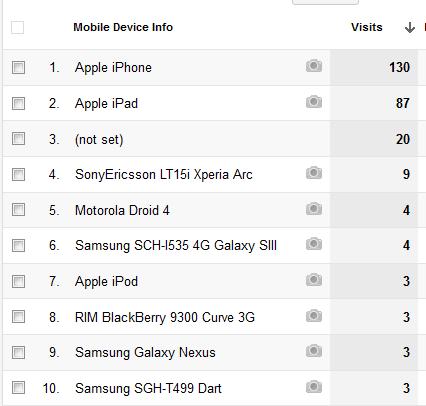
Mobile Traffic Oct 2012
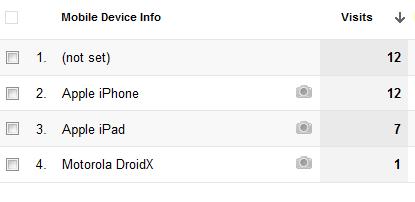
Mobile Traffic 2011As consumers we are used to consuming content where we want to and when we want to. We are consuming across platforms. We are mixing our consumption of entertainment and work related content throughout the day and evening. And it’s easy. We now feel entitled. The same philosophy needs to be applied to how you sell to the B2B buyer. If they want to consider purchasing your solution on a Sunday evening let them.
Bottom line you need digital content because there are more people involved in the buying process. You need to share it effectively and you need to deliver your message in multiple formats so your buyer can educate and buy on their timeline and schedule, not yours.
You need to meet the buyer where they are in their buying cycle and not force them into your “sales cycle”
Inbound leads are coming much earlier in the decision making process when buyers are still at the education phase which means your initial job as a sales and marketing team is to educate first. This means you need to help educate a potential buyer before you “sell”. This gets tricky because this can increase your costs if you are over investing in “selling” to buyers that are not ready to transact. The flip side and potentially even more daunting is that we are now seeing that 25% of your buyers make their purchase decision after self-education and calling a sales rep after short listing online (Sirius -2012). This means that your team needs to be able to quickly figure out where a buyer is in the buying cycle quickly so they can treat them appropriately. So there is both an upside and a downside it getting this right.
If you sell too hard early we know that:
- 70% of leads are passed to Sales Reps before they are ready to engage ( Marketing Sherpa -2012)
- 80% of mishandled leads will buy from a competitor (Forrester -2011)
If you get it right we know that:
- “Well nurtured leads close 23% faster and result in 40% more revenue” (Aberdeen-2012)
Summary
What’s happening right now is not a small shift. It’s the final transformation that was the promise of a connected world when the Internet first reared its head in almost 30 years ago. And in the last 2 years the shift is accelerating dramatically. Since the birth of modern banking during the Renaissance (and possibly before) the majority of transactions have been driven by a seller and buyer relationship. The seller had information and shared it with the buyer and then the buyer bought. What we are witnessing right now is the final stages of the seismic shift that has been slowly taking place since we first got the internet in the mid 90s and Google organized it for immediate access 10 years later. They buyer now expects to be able to buy without the intervention of sales whenever possible. They expect honest and authentic information and they want it now. If you don’t get prepared to do this for your buyer – to make this process fast, easy, not deeply sales rep dependent and your competitor does you will lose.
To learn what this cultural shift means for your own sales and marketing culture please check out the next blog in this series for things to consider as you ponder the obvious question What Does All this Mean for Your Business?
If all this seems a bit daunting in the short term you can also feel free to check out our Sell Smarter and Sell Fast Whitepaper to learn about short term tactics you can implement on your own right now.
Here are some quick links for additional reading:
Part 1 – Increasing Your B2B Sales Volume and Revenue – What’s Changed?
Part 2 – What Does Your B2B Sales and Marketing Culture Need to Look Like?
Part 3 – What Core Competencies do I Need From My Marketing and Lead Generation Team?
Part 4 – How Can Marketing Automation Improve My B2B Sales Performance?
Part 5 – Why is Content Marketing is Now Required for Quality B2B Lead Generation?
by gabriel_sales | Oct 8, 2012
Three Best Practices for Better B2B Lead Scoring
The new rules of engagement require you to get smarter about how you work the phone to ensure that you maximize every dollar spent on phone work. One requirement for b2b lead generation is to align your inside sales team with your marketing team by intelligently leveraging a marketing automation platform like Pardot for better lead scoring. This blog is part 2 of a 2 part series. Part 1 addressed the basics of sales b2b lead scoring to improve the performance of your sales and marketing b2b lead generation investment. Part 2 now introduces a framework to make your content marketing easier with a couple simple tips and some tool suggestions.
What’s does a solid process look like?
A solid process requires the basics we discussed in Part 1 of this series and the ability to capture both inferred data and direct data.
As each lead takes any action, their score will change. Your sales reps need to leverage your CRM to capture the Direct Data when they engage the prospect. Your Marketing teams will also collect direct data with well-built forms for inbound leads. Marketing Automation Software and a smart Content Management System makes collecting inferred data easy because it will track what type of content your prospects are looking at when they are visiting your website and social media sites. What you end up with is a composite score. The higher the score, the more qualified the lead. Below is a picture pulled from our platform.
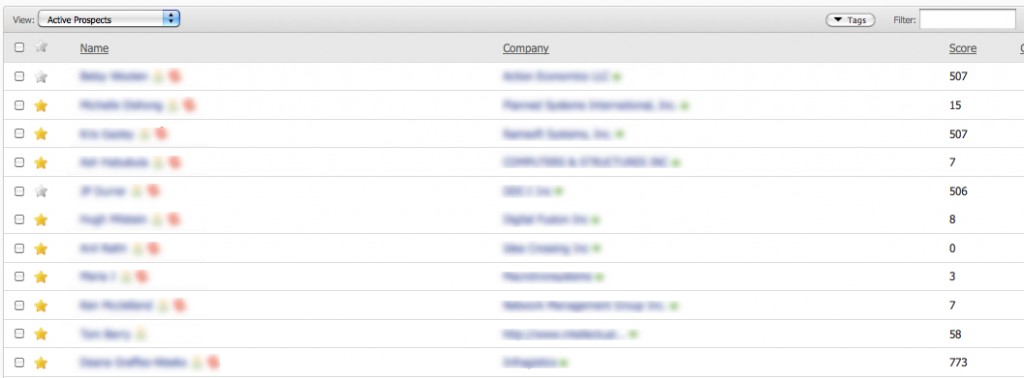
How do I Score My Content? – B2B Lead Scoring Best Practice #2
The key to making your marketing automation software more productive is to design content around specific buying stages.

From there B2B lead scoring is easy:
- Educational Content like basic blog posts would get a score of 1
- Richer Educational Content and Whitepapers would get a score of 5
- Road Maps, Media Kits and Sales Sheets, Comparisons would get a score of 25
- Rate Cards, About Us Pages, Case Studies, and Technical Sheets would get a score of 100 and you would immediately flag these for sales to jump on to determine next actions
What if I Don’t Have A Lot of Content? – B2B Lead Scoring Best Practice #3
You need to get smarter about making your content work harder with a smart content management system that’s easy for non-technical employees to use (like WordPress) and a custom install of Gabriel Sales Digital Sales Basecamp™ as a tool to both, isolate content and to create landing pages, with a click of a mouse. This system allows you to customize your content for specific verticals, repurpose you content for specific decision makers so they can self-educate and, simultaneously, to isolate your content around specific buying stages.
The second step is to use a smart content management system like Gabriel Sales Digital Sales Basecamp and your Blog to organize your content so buyers can self- educate more easily and so you can offer your buyer different stage content on the same page.
Learn how to build a powerful B2B lead generation system, integrating sales and marketing, by viewing our resource page here.
by gabriel_sales | Oct 4, 2012
B2B lead generation has changed more in the past 18 months than we have seen in the previous 12 years we have been providing outsourced b2b lead generation through sales lead scoring as an outsourced b2b lead generation company. One of the largest drivers is the simple fact that your buyers are answering the phone 50% less than they did 18 months ago. Across the board our calls to connect ratio (someone actually picking up the phone) has dropped from 15%-22% to 8%-12%. With all these changes, it’s critical that you maximize the result of every lead, which requires you do a better job of lead scoring.
This blog is part 1 of a 2 part series. Part 1 will address the basics of sales lead scoring to improve the performance of your sales and marketing b2b lead generation investment. Part 2 will introduce a lead scoring best practices framework to make your content marketing easier with a couple simple framework tips and some tool suggestions.
1. What is sales lead scoring?
Sales lead scoring is the ability to figure out where someone is in their buying process. It is a process that combines information gathered by you telemarketers through some basic qualifying questions with the type of content a buyer is consuming and creating a numerical value that ranks the buyers level of interest and their ability to transact with you (are they an influencer or can they sign the agreement?). Sales lead scoring allows sales and marketing to quickly flag who should go to higher end sales reps and who should not.
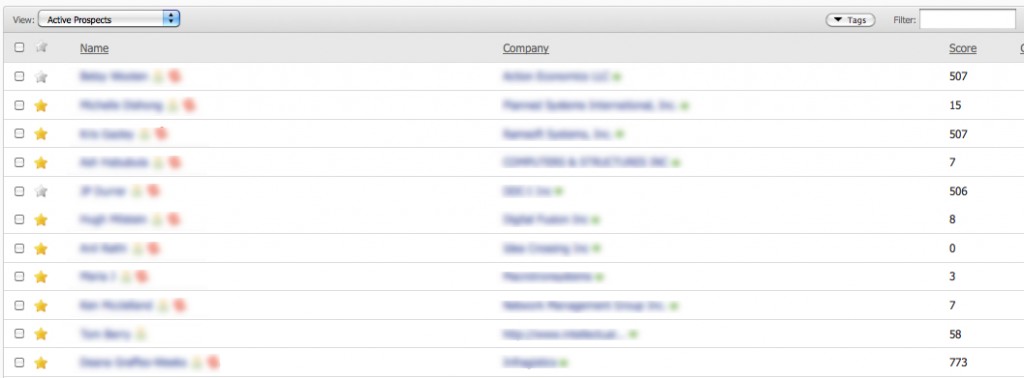
2. What is the first step in lead scoring?
It’s critical that everyone agrees on the “lead” definition. The more complex the sale is, the tougher this can be, especially if your sale requires someone on the buyer side to champion it through the organization or if the technical influencer takes the lead in the early buying process. The important thing is that there is agreement. And the most important person to get agreement from is your sales team There’s no point in your marketing team scoring leads alone because if sales does not agree with marketing on what a quality lead is there will be conflict and you are simply going to end up where you started.
3. Why do I need to score sales leads?
In a word: Money. Scoring sales leads will lead to more revenue because better leads (buyers ready for sales) will get to your sales team faster. Scoring leads will also save you money because leads that are not ready to buy can be managed by less expensive inside reps during the early education stages of your buying cycle or even better by your marketing team leveraging digital content in an automated process.
4. What Types of Data Do I Need to Score Leads?
Lead scoring is comprised of two parts: “direct” and “inferred” information; both types of information are important. Direct is gathered by your inside sales team when they pick up the phone and ask buyers questions and “Engage” them. It’s also gathered by keeping track of the title, business vertical and company size etc. Inferred information is gathered by keeping tracking of the type of content your buyer is consuming.
Direct Data – When your inside rep engages the buyer, he/she figures out if the leads is a fit. Does your your product meet a need? Does the buyer know their need? Can the buyer sign the check? Is the buyer an influencer or not? Is there a budget for the project or not? Also the rep can cover any gaps in the basic lead info that marketing did not collect like company size, industry segment, job title, and location.
Infered Data – Data gathered from the digital consumption of your content: number of pages visits, specific web pages visited, recency of response, email activity, social media activity, online event registrations or downloads.
Hopefully this blog was helpful in explaining the basics of sales lead scoring. In part 2 we will discuss what a solid lead scoring best practice process looks like and make some recommendations around how to frame your content and tools you can use to make your content work harder.
Learn how to build a powerful B2B lead generation system, integrating sales and marketing, by viewing our resource page here.
by gabriel_sales | Sep 13, 2012
Marketing Automation Outsourcing Can Be Accelerated with Content that Helps both Your Sales Team and Your Lead Generation Efforts
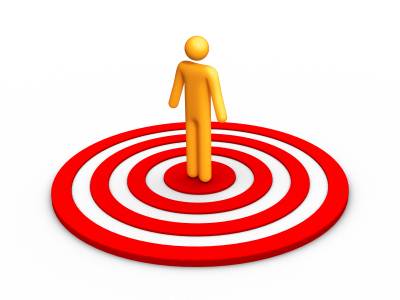 As an outsourced sales and marketing company we now require quality sales content to successfully do our job. To accelerate our demand generation engine we execute specific campaigns to put new leads in the pipe to accelerate the Marketing Automation Outsourcing services we provide. Below is a recent survey of what your peers and mature competitors are doing to win in the market place. And below that in this blog we prioritize what we provide as an outsourced sales and marketing company on the content front to support your successful sales efforts as we build demand generation engines.
As an outsourced sales and marketing company we now require quality sales content to successfully do our job. To accelerate our demand generation engine we execute specific campaigns to put new leads in the pipe to accelerate the Marketing Automation Outsourcing services we provide. Below is a recent survey of what your peers and mature competitors are doing to win in the market place. And below that in this blog we prioritize what we provide as an outsourced sales and marketing company on the content front to support your successful sales efforts as we build demand generation engines.

Combining Sales Collateral with a Marketing Automation Outsourcing Solution
Here is a quick list of the content we need and prioritize to help support your sales and to accelerate your marketing automation outsourcing solution simultaneously. Typically when we engage with a new client we either help to implement a marketing automation outsourcing solution or execute a campaign specifically to implement some of our marketing automation outsourcing best practices.
Blogs – We generally find that we get the biggest bang for the effort and the buck especially when launching new sales efforts. The majority of what we need to get a sales effort underway can be done with your thought leadership through quick blog posts. Especially in the early stages of engaging a prospect.
Microsites – Gabriel Sales deploys our proprietary Gabriel Sales Digital Sales Base Camp™ as part of every engagement. This allows us to quickly re- contextualize your existing content for specific target markets. As an outsourced sales and marketing company this helps all your marketing and sales content, both current and to be created, work harder and faster for you.
Case Studies – These don’t need to be incredibly technical. Keep your case studies business and solution focused. They help your sales reps qualify if a potential buyer is a fit.
Webcasting – We love webcasting as a tool and tactic. They are the gift that keeps on giving and helps to reduce your COS% because we can introduce your thought leaders, sales engieneer and product specialist so they can sell one to many and we are engaging your buyers 1:1.
White Papers – We love white papers but you need to be prepared to drive some serious value with them. We help our clients design White Paper that can be re-leveraged for additional blog posts and integrated into a complimentary Webcasting Series. Given a choice between webcasting and white papers we generally lead with Webcasting. They are faster and typically more valuable in moving qualified deals deeper into the pipe.
E-Newsletter – Once you have the above bases covered these are easy to create.
Social Media – We lean heavily on Linked In and for some technologies we sell we advocate Twitter. From our perspective adding Facebook and a half dozen other channels simply need to be automated with RSS feed.
For a deeper dive how your company can align sales and marketing with smarter content marketing lease check out our knowledge center How to Integrate Content Marketing.
To learn more about how we can help to prioritize your sales content marketing strategy to accelerate deal flow through your pipe line please feel free to reach out for a quick conversation.










 As an outsourced sales and marketing company we now require quality sales content to successfully do our job. To accelerate our demand generation engine we execute specific campaigns to put new leads in the pipe to accelerate the Marketing Automation Outsourcing services we provide. Below is a recent survey of what your peers and mature competitors are doing to win in the market place. And below that in this blog we prioritize what we provide as an outsourced sales and marketing company on the content front to support your successful sales efforts as we
As an outsourced sales and marketing company we now require quality sales content to successfully do our job. To accelerate our demand generation engine we execute specific campaigns to put new leads in the pipe to accelerate the Marketing Automation Outsourcing services we provide. Below is a recent survey of what your peers and mature competitors are doing to win in the market place. And below that in this blog we prioritize what we provide as an outsourced sales and marketing company on the content front to support your successful sales efforts as we 
